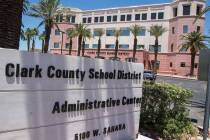Comparing schools: At-risk students face extra challenges
Rebecca A. Johnson was at Robert Taylor Elementary School Aug. 3 preparing for the academic year as a new principal at a Title I school. She has five full-time teacher's positions to fill.
"It is a little scary going into the new school year knowing the district has 700 to 900 vacancies districtwide," Johnson said.
The fact that the school at 144 Westminster Way is Title I sometimes influences teacher recruitment, she said. Some teachers may shy away because of that status, such as if they don't have a proper background for it, but others are drawn to such schools.
"There are teachers that look specifically for Title I schools," Johnson said. "Occasionally, you'll come across people who just want to work with struggling students. I have spoken to several candidates who look specifically for Title 1 schools or at-risk schools because that's their background."
For the most part, however, teachers want to work in their neighborhood, she said.
"I know, for a lot of people, the main factor is location," she said. "People are looking for places that are close to home."
Before her job at Taylor, Johnson was principal at Adams Elementary School, 580 Fogg St., for 13 years.
Students' socioeconomic backgrounds can be a significant factor in their academic performance, Johnson said. The academic support students receive in low-income households can sometimes be lacking, she said.
Some low-income families are unable to prepare their children for school because they don't have the proper education or have two jobs, among other reasons, Johnson said.
"In these neighborhoods, the kids don't come ready to learn," she said. "When you have schools with kids who don't have that background, you're starting with a deficit."
Language barriers also are a factor, she said.
"In some neighborhoods, you're going to find a very high ESL ELL (English as a second language and English language learner) population," she said.
The Nevada Department of Education's website shows that enrollment in free and discounted lunch programs at Taylor was 76 percent for the 2013-14 school year, reflecting students' low-income backgrounds.
Taylor was rated as a three-star school in 2013-14 on the website. Schools with three stars have index scores between 50 and 67. Elementary and middle school index scores are based on students' academic growth and other indicators, while at high schools, they're based on student proficiency, college and career readiness and other indicators.
Dr. Joe Morgan, assistant professor of special education and coordinator of special education programs in the UNLV Department of Educational and Clinical Studies, said there is a link between schools with lower star ratings and economically disadvantaged neighborhoods.
"We know that in areas where there are one- or two-star schools, there is also a higher concentration of students living in poverty, students who are English learners or students with special needs," he said.
Brown Junior High School, 307 Cannes St., had a 55 percent participation rate in free and discounted lunch programs in 2013-14, yet the Title I school received a five-star rating. Index scores at five-star schools total 77 or more.
Brown assistant principal Melissa Mendoza said the school has a good team of educators to help bolster student performance.
"We have really, really good teachers, and they really devote themselves to the students here," she said. "They have high standards, and we believe that every child can learn."
She said the school also does a good job supplementing the teacher training regularly provided by the Clark County School District.
"Schools have to provide professional development, and you train teachers in the direction you want to go," she said.
Brown was fully staffed with teachers going into the new school year, Mendoza said.
The same held true at Webb Middle School, 2200 Reunion Drive, vice principal Todd Peterson said. Webb was rated as a five-star school by the state education department, with 19 percent of students taking part in free or discounted lunch programs.
One of the top concerns at Webb regarding the new academic year was the road construction underway near the school, which might hinder school buses and parents dropping off and picking up students, he said.
Despite the four portable classrooms at the campus, things were looking good for the school as far as buildings and grounds, Peterson said. He also had no complaints as far as technology.
"We have numerous computers on campus," Peterson said.
That includes the computer labs at the facility and laptops that teachers can use for classes, he said.
Johnson said some schools are better equipped with such tools than others. The district provides updated technology at all valley schools on a rotating basis.
"We got fitted with new computers about two years ago," Mendoza said.
Still, schools also can purchase their own equipment through means such as grants and fundraising, Johnson said.
That's what Sewell Elementary School does, principal Holli Ratliff said. In fact, grants are a priority at the Title I school at 700 E. Lake Mead Parkway, which has a five-star rating and was named a model school last year from the National Title I Association.
"We write many grants to make sure we have extra resources," she said. "One of those is we have a grant for tutoring both before and after school, so we're able to provide increased learning opportunities for our students, and also, we're able to include intramural activities for students as a part of our after-school sessions."
Grants also are a resource to supplement technology at the school, she said.
"We've written quite a few grants for technology, as well," Ratliff said. "We know that our children need that access to computers. We definitely try to keep up with what's out there."
Sewell is fully staffed with teachers. When hiring for the positions, the school targets "teachers that are passionate and committed to children," Ratliff said. Parents also play a role in their children's academic success, she said.
"We have a very involved parent community group," she said. "We recognize the value of parents as partners in their children's education. We look for ways to have parents involved (at home and in school)."
— To reach Henderson View reporter Cassandra Keenan, email ckeenan@viewnews.com or call 702-383-0278. Find her on Twitter: @CassandraKNews.






























